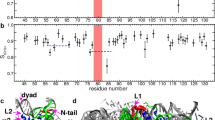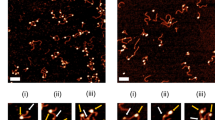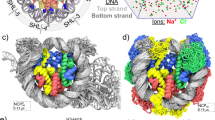Abstract
The dynamic interaction of chromatin-binding proteins with their nucleosome binding sites is an important element in regulating the structure and function of chromatin in living cells. Here we review the major factors regulating the intranuclear mobility and chromatin binding of the linker histone H1, the most abundant family of nucleosome-binding proteins. The information available reveals that multiple and diverse factors modulate the interaction of H1 with chromatin at both a local and global level. This multifaceted mode of modulating the interaction of H1 with nucleosomes is part of the mechanism that regulates the dynamics of the chromatin fiber in living cells.
This is a preview of subscription content, access via your institution
Access options
Subscribe to this journal
Receive 12 print issues and online access
$189.00 per year
only $15.75 per issue
Buy this article
- Purchase on Springer Link
- Instant access to full article PDF
Prices may be subject to local taxes which are calculated during checkout




Similar content being viewed by others
References
Luger, K. & Hansen, J.C. Nucleosome and chromatin fiber dynamics. Curr. Opin. Struct. Biol. 15, 188–196 (2005).
Bustin, M., Catez, F. & Lim, J.H. The dynamics of histone H1 function in chromatin. Mol. Cell 17, 617–620 (2005).
Harvey, A.C. & Downs, J.A. What functions do linker histones provide? Mol. Microbiol. 53, 771–775 (2004).
Brown, D.T. Histone H1 and the dynamic regulation of chromatin function. Biochem. Cell Biol. 81, 221–227 (2003).
Parseghian, M.H. & Hamkalo, B.A. A compendium of the histone H1 family of somatic subtypes: an elusive cast of characters and their characteristics. Biochem. Cell Biol. 79, 289–304 (2001).
Khochbin, S. Histone H1 diversity: bridging regulatory signals to linker histone function. Gene 271, 1–12 (2001).
Kasinsky, H.E., Lewis, J.D., Dacks, J.B. & Ausio, J. Origin of H1 linker histones. FASEB J. 15, 34–42 (2001).
Georgel, P.T. & Hansen, J.C. Linker histone function in chromatin: dual mechanisms of action. Biochem. Cell Biol. 79, 313–316 (2001).
Thomas, J.O. Histone H1: location and role. Curr. Opin. Cell Biol. 11, 312–317 (1999).
Wolffe, A.P., Khochbin, S. & Dimitrov, S. What do linker histones do in chromatin? Bioessays 19, 249–255 (1997).
Van Holde, K.E. Chromatin (Springer-Verlag, New York, 1988).
Woodcock, C.L., Skoutchi, A.I. & Fan, Y. Role of linker histone in chromatin structure and function: H1 stoichiometry and nucleosome repeat length. Chromosome Res. 14, 17–25 (2006).
Misteli, T., Gunjan, A., Hock, R., Bustin, M. & Brown, D.T. Dynamic binding of histone H1 to chromatin in living cells. Nature 408, 877–881 (2000).
Lever, M.A., Th'ng, J.P., Sun, X. & Hendzel, M.J. Rapid exchange of histone H1.1 on chromatin in living human cells. Nature 408, 873–876 (2000).
Catez, F. et al. Network of dynamic interactions between histone H1 and high-mobility-group proteins in chromatin. Mol. Cell. Biol. 24, 4321–4328 (2004).
Catez, F., Brown, D.T., Misteli, T. & Bustin, M. Competition between histone H1 and HMGN proteins for chromatin binding sites. EMBO Rep. 3, 760–766 (2002).
Phair, R.D. et al. Global nature of dynamic protein-chromatin interactions in vivo: three-dimensional genome scanning and dynamic interaction networks of chromatin proteins. Mol. Cell. Biol. 24, 6393–6402 (2004).
Roix, J. & Misteli, T. Genomes, proteomes, and dynamic networks in the cell nucleus. Histochem. Cell Biol. 118, 105–116 (2002).
Zlatanova, J., Caiafa, P. & Van Holde, K. Linker histone binding and displacement: versatile mechanism for transcriptional regulation. FASEB J. 14, 1697–1704 (2000).
Ausio, J. Are linker histones (histone H1) dispensable for survival? Bioessays 22, 873–877 (2000).
Downs, J.A., Kosmidou, E., Morgan, A. & Jackson, S.P. Suppression of homologous recombination by the Saccharomyces cerevisiae linker histone. Mol. Cell 11, 1685–1692 (2003).
Hellauer, K., Sirard, E. & Turcotte, B. Decreased expression of specific genes in yeast cells lacking histone H1. J. Biol. Chem. 276, 13587–13592 (2001).
Lin, Q. et al. Reductions in linker histone levels are tolerated in developing spermatocytes but cause changes in specific gene expression. J. Biol. Chem. 279, 23525–23535 (2004).
Shen, X., Yu, L., Weir, J.W. & Gorovsky, M.A. Linker histones are not essential and affect chromatin condensation in vivo. Cell 82, 47–56 (1995).
Takami, Y., Nishi, R. & Nakayama, T. Histone H1 variants play individual roles in transcription regulation in the DT40 chicken B cell line. Biochem. Biophys. Res. Commun. 268, 501–508 (2000).
Wierzbicki, A.T. & Jerzmanowski, A. Suppression of histone H1 genes in Arabidopsis results in heritable developmental defects and stochastic changes in DNA methylation. Genetics 169, 997–1008 (2004).
Fan, Y. et al. H1 linker histones are essential for mouse development and affect nucleosome spacing in vivo. Mol. Cell. Biol. 23, 4559–4572 (2003).
Fan, Y. & Skoultchi, A.I. Genetic analysis of H1 linker histone subtypes and their functions in mice. Methods Enzymol. 377, 85–107 (2004).
Fan, Y. et al. Histone H1 depletion in mammals alters global chromatin structure but causes specific changes in gene regulation. Cell 123, 1199–1212 (2005).
Mellor, J. The dynamics of chromatin remodeling at promoters. Mol. Cell 19, 147–157 (2005).
Hendzel, M.J., Lever, M.A., Crawford, E. & Th'ng, J.P. The C-terminal domain is the primary determinant of histone H1 binding to chromatin in vivo. J. Biol. Chem. 279, 20028–20034 (2004).
Gunjan, A., Alexander, B.T., Sittman, D.B. & Brown, D.T. Effects of H1 histone variant overexpression on chromatin structure. J. Biol. Chem. 274, 37950–37956 (1999).
Brown, D., Izard, T. & Misteli, T. Mapping the interaction surface of the linker H1 with the nucleosome of native chromatin in vivo. Nat. Struct. Mol. Biol., 13, 250–255 (2006).
Houtsmuller, A.B. & Vermeulen, W. Macromolecular dynamics in living cell nuclei revealed by fluorescence redistribution after photobleaching. Histochem. Cell Biol. 115, 13–21 (2001).
Phair, R.D. & Misteli, T. Kinetic modelling approaches to in vivo imaging. Nat. Rev. Mol. Cell Biol. 2, 898–907 (2001).
Krouwels, I.M. et al. A glue for heterochromatin maintenance: stable SUV39H1 binding to heterochromatin is reinforced by the SET domain. J. Cell Biol. 170, 537–549 (2005).
Th'ng, J.P., Sung, R., Ye, M. & Hendzel, M.J. H1 family histones in the nucleus. Control of binding and localization by the C-terminal domain. J. Biol. Chem. 280, 27809–27814 (2005).
Becker, M. et al. Differential in vivo binding dynamics of somatic and oocyte-specific linker histones in oocytes and during ES cell nuclear transfer. Mol. Biol. Cell 16, 3887–3895 (2005).
Teranishi, T. et al. Rapid replacement of somatic linker histones with the oocyte-specific linker histone H1foo in nuclear transfer. Dev. Biol. 266, 76–86 (2004).
Meshorer, E. et al. Hyperdynamic plasticity of chromatin proteins in pluripotent embryonic stem cells. Dev. Cell 10, 105–116 (2006).
Bustin, M., Rall, S.C., Stellwagen, R.H. & Cole, R.D. Histone structure: asymmetric distribution of lysine residues in lysine-rich histone. Science 163, 391–393 (1969).
Lu, X. & Hansen, J.C. Revisiting the structure and functions of the linker histone C-terminal tail domain. Biochem. Cell Biol. 81, 173–176 (2003).
Bharath, M.M., Ramesh, S., Chandra, N.R. & Rao, M.R. Identification of a 34 amino acid stretch within the C-terminus of histone H1 as the DNA-condensing domain by site-directed mutagenesis. Biochemistry 41, 7617–7627 (2002).
Lu, X. & Hansen, J.C. Identification of specific functional subdomains within the linker histone H10 C-terminal domain. J. Biol. Chem. 279, 8701–8707 (2004).
Alexandrow, M.G. & Hamlin, J.L. Chromatin decondensation in S-phase involves recruitment of Cdk2 by Cdc45 and histone H1 phosphorylation. J. Cell Biol. 168, 875–886 (2005).
Horn, P.J. et al. Phosphorylation of linker histones regulates ATP-dependent chromatin remodeling enzymes. Nat. Struct. Biol. 9, 263–267 (2002).
Chen, D. et al. Condensed mitotic chromatin is accessible to transcription factors and chromatin structural proteins. J. Cell Biol. 168, 41–54 (2005).
Contreras, A. et al. The dynamic mobility of histone H1 is regulated by cyclin/CDK phosphorylation. Mol. Cell. Biol. 23, 8626–8636 (2003).
Dou, Y. & Gorovsky, M.A. Phosphorylation of linker histone H1 regulates gene expression in vivo by creating a charge patch. Mol. Cell 6, 225–231 (2000).
Dou, Y., Bowen, J., Liu, Y. & Gorovsky, M.A. Phosphorylation and an ATP-dependent process increase the dynamic exchange of H1 in chromatin. J. Cell Biol. 158, 1161–1170 (2002).
Vaquero, A. et al. Human SirT1 interacts with histone H1 and promotes formation of facultative heterochromatin. Mol. Cell 16, 93–105 (2004).
Daujat, S., Zeissler, U., Waldmann, T., Happel, N. & Schneider, R. HP1 binds specifically to Lys26-methylated histone H1.4, whereas simultaneous Ser27 phosphorylation blocks HP1 binding. J. Biol. Chem. 280, 38090–38095 (2005).
Smith, C.L. & Peterson, C.L. ATP-dependent chromatin remodeling. Curr. Top. Dev. Biol. 65, 115–148 (2005).
Martic, G. et al. Parathymosin affects the binding of linker histone H1 to nucleosomes and remodels chromatin structure. J. Biol. Chem. 280, 16143–16150 (2005).
Hill, D.A. & Reeves, R. Competition between HMG-I(Y), HMG-1 and histone H1 on four-way junction DNA. Nucleic Acids Res. 25, 3523–3531 (1997).
Varga-Weisz, P., van Holde, K. & Zlatanova, J. Competition between linker histones and HMG1 for binding to four-way junction DNA: implications for transcription. Biochem. Biophys. Res. Commun. 203, 1904–1911 (1994).
Zhao, K., Kas, E., Gonzalez, E. & Laemmli, U.K. SAR-dependent mobilization of histone H1 by HMG-I/Y in vitro: HMG-I/Y is enriched in H1-depleted chromatin. EMBO J. 12, 3237–3247 (1993).
Ner, S.S. et al. HMG-D and histone H1 interplay during chromatin assembly and early embryogenesis. J. Biol. Chem. 276, 37569–37576 (2001).
Bustin, M. Regulation of DNA-dependent activities by the functional motifs of the high-mobility-group chromosomal proteins. Mol. Cell. Biol. 19, 5237–5246 (1999).
Bianchi, M.E. & Agresti, A. HMG proteins: dynamic players in gene regulation and differentiation. Curr. Opin. Genet. Dev. 15, 496–506 (2005).
Harrer, M., Luhrs, H., Bustin, M., Scheer, U. & Hock, R. Dynamic interaction of HMGA1a proteins with chromatin. J. Cell Sci. 117, 3459–3471 (2004).
Muller, S., Ronfani, L. & Bianchi, M.E. Regulated expression and subcellular localization of HMGB1, a chromatin protein with a cytokine function. J. Intern. Med. 255, 332–343 (2004).
Furusawa, T. et al. Down-regulation of nucleosomal binding protein HMGN1 expression during embryogenesis modulates Sox9 expression in chondrocytes. Mol. Cell. Biol. 26, 592–604 (2006).
Alami, R. et al. Mammalian linker-histone subtypes differentially affect gene expression in vivo. Proc. Natl. Acad. Sci. USA 100, 5920–5925 (2003).
Lee, H., Habas, R. & Abate-Shen, C. MSX1 cooperates with histone H1b for inhibition of transcription and myogenesis. Science 304, 1675–1678 (2004).
Lippincott-Schwartz, J., Snapp, E. & Kenworthy, A. Studying protein dynamics in living cells. Nat. Rev. Mol. Cell Biol. 2, 444–456 (2001).
Acknowledgements
This work was supported by the Center for Cancer Research, NCI, through the Intramural Research Program of the US National Institutes of Health. We thank M. Wittenberger, G. Gerlitz and D. Landsman for helpful comments on the manuscript and T. Misteli for critical comments, for numerous discussions on the topic and for providing access to his manuscripts before their publication.
Author information
Authors and Affiliations
Corresponding author
Ethics declarations
Competing interests
The authors declare no competing financial interests.
Rights and permissions
About this article
Cite this article
Catez, F., Ueda, T. & Bustin, M. Determinants of histone H1 mobility and chromatin binding in living cells. Nat Struct Mol Biol 13, 305–310 (2006). https://doi.org/10.1038/nsmb1077
Published:
Issue Date:
DOI: https://doi.org/10.1038/nsmb1077
This article is cited by
-
H3K27ac nucleosomes facilitate HMGN localization at regulatory sites to modulate chromatin binding of transcription factors
Communications Biology (2022)
-
Release of linker histone from the nucleosome driven by polyelectrolyte competition with a disordered protein
Nature Chemistry (2022)
-
Chromatin regulates IL-33 release and extracellular cytokine activity
Nature Communications (2018)
-
Destabilization of linker histone H1.2 is essential for ATM activation and DNA damage repair
Cell Research (2018)
-
Post-translational modifications of the intrinsically disordered terminal domains of histone H1: effects on secondary structure and chromatin dynamics
Chromosoma (2017)



